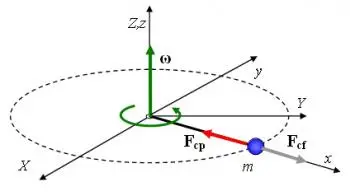
When it comes to understanding circular motion and the forces that govern it, it is essential to clarify the difference between centrifugal force and centripetal force.
These two concepts, although often mentioned together, are actually opposites in their nature and effect.
In this article, we will explain in detail the distinction between both forces, how they originate, and how they are applied in real-world situations.
Centrifugal force: a perceptual illusion
Let's start by addressing centrifugal force, which is actually a perceptual illusion rather than a real force. Centrifugal force is the sensation we experience when an object moving in circles appears to be "thrown outward" from the center of the trajectory. This is due to the inertia of an object in circular motion, which tends to continue moving in a straight line unless a force is applied to it that forces it to change direction.
 Centrifugal force is the "fictitious force" that we perceive when we are on an object in circular motion.
Centrifugal force is the "fictitious force" that we perceive when we are on an object in circular motion.
For example, if you are in a car turning a curve, you feel like you are being pushed out of the curve, toward the door. However, in reality, there is no force pushing you out; your body simply tends to keep moving in a straight line due to inertia.
This illusion is due to the acceleration of the vehicle towards the center of the curve (the true force, which we will explain later), which causes you to feel an outward "force" in the opposite direction.
Centripetal force: the real force in circular motion
Centripetal force, on the other hand, is a real force that acts on circular motion and prevents an object from following a straight path.
Its name, "centripetal," comes from the Latin words "centrum" (center) and "petere" (seek), which means "seek the center."
Centripetal force is what forces an object to constantly move towards the center of the circular path, preventing it from continuing in a straight line.
In the example of the car turning a curve, centripetal force is the actual force the car exerts on you to keep you in the curve. This force acts in the direction of the center of the curve, counteracting the inertia of your body and preventing you from moving in a straight line. Without centripetal force, the car would not be able to stay in the curve and would continue in a straight line.
Origins of Centrifugal Force and Centripetal Force
The fundamental difference between centrifugal force and centripetal force lies in their origin and direction:
In centrifugal force, the sensation of being thrown outward in a circular motion is an illusion caused by the inertia of objects that tend to move in a straight line. The direction of motion is perceived as acting outward from the center of the circular path, although it is not actually a real force in action.
On the other hand, centripetal force is a real force that originates from the interaction between an object and the force that keeps it in a circular path. It acts towards the center of the circular path, keeping the object in its circular path.
Examples of both forces
To better understand these differences, let's consider concrete examples:
A classic example of the illusion of centrifugal force is water in a rapidly rotating bucket. Although the water does not spill out of the bucket, it appears to do so due to the perception of centrifugal force.
In the case of centripetal force, think of a roller coaster. The forces you experience as you move through loops and curves are real examples of centripetal force in action. The design of the roller coaster and the speed at which it travels are designed to apply the centripetal force necessary to keep passengers in their seats and on the circular path.
Conclusion
The difference between centrifugal force and centripetal force is essential to understanding circular motion.
Centrifugal force is a perceptual illusion caused by the inertia of objects in circular motion, while centripetal force is a real force that acts towards the center of the circular path, keeping objects in their path.
Both concepts have applications in everyday life and science, and understanding their difference is essential to accurately address phenomena related to circular motion.